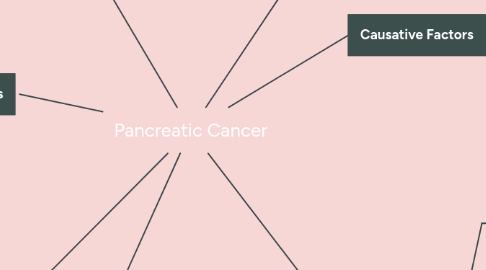
1. Risk Factors
1.1. Panceatitis
1.2. Obesity
1.3. Diabetes
1.3.1. A combination of these risk factors increases the risk of developing pancreatic cancer than one risk factor alone; long standing diabetes, cigarette smoking and poor diet.
1.4. Smoking
1.5. Direct relative with history of Pancreatic Cancer.
1.6. Older age, 65 and older
1.7. Family history of genetic syndromes such as: BRCA2 gene mutation, Lynch syndrome and familial atypical mole-malignant melanoma (FAMMM) syndrome.
2. Diagnostic Tests
2.1. CT, MRI, PET Scan, Ultra Sounds
2.2. Endoscopic Ultra Sound
2.3. Needle Aspiration Biospy
2.4. Blood test, CA19-9 tumor marker
2.5. Genetic testing if one has a family history of Pancreatic Cancer.
3. Common Findings
3.1. Signs and Symptoms do not usually present until the disease is in the advanced stages.
3.1.1. Pain in the abdomen that radiates to the back
3.1.2. Loss of apetite and unintended weight loss
3.1.3. Jaundice
3.1.4. Depression
3.1.5. New Onset Diabetes
3.1.6. Blood Clots/ DVT
3.1.7. Fatigue
4. Pathophysiologic Factors
4.1. Metastasis to the liver, causes liver failure and is the number one cause of death in Pancreatic cancer patients.
4.2. Pancreatic cancer causes systemic inflammation with elevated levels of Interleukin (IL) 1-B, and IL-6, elevated levels of ILs have been associated with venous thromboembolism.
4.3. Cachexia, this is a multi-systemic syndrome which causes multiple metabolic disturbances, lean mass catabolism, anorexia and fatigue. An estimated 83% of all patients with pancreatic cancer experience this.
5. Pathophysiologic Etiology
5.1. Two types of Pancreatic Cancer: Exocrine (most common) and Endocrine.
5.1.1. 95% of cancers in the pancreas are exocrine pancreatic adenocarcinoma.
5.1.1.1. Pancreatic ductal adenocarcinoma evolve through non-invasive precursor lesions, usually intra-epithelial neoplasias.
5.1.1.1.1. These neoplasias go through genetic and epigenetic changes.
5.1.2. 5% of the cancers in the pancreas are endocrine, they are called neuroendocrine tumors (NET), they can be benign of malignant.
5.1.2.1. Can evolve from papillary mucinous neoplasms or mucinous cystic neoplasms
6. Causative Factors
6.1. In most cases it is unclear what causes the cancer, the only modifiable risk factor is smoking.
7. Treatments
7.1. The first goal would be to remove the cancer with surgery, if it is not too advanced this treatment has fewer complications.
7.1.1. Surgery
7.1.1.1. If the tumor is in the pancreatic head, a Whippple is usually indicated: the head of the pancreas is removed, duodenum, gallbladder, common bile duct and sometimes part of the stomach and lymph nodes.
7.1.1.2. If the tumor is in the pancreatic tail, then the distal portion of the pancreas is removed and possibly the spleen
7.1.1.3. The whole pancreas can be removed in a total pancreatectomy, the patient would be insulin dependent and require enzyme supplementation after.
7.2. If the cancer has extended beyond the pancreas then chemotherapy is indicated
7.2.1. Chemotherapy
7.2.1.1. Can be given IV and Orally
7.2.1.2. Sometimes combined with radiation
7.2.1.2.1. Chemoradiation is typically used to treat cancer that has spread beyond the pancreas, but only to nearby organs and not to distant regions of the body.
7.2.1.3. In advanced pancreatic cancer chemo can be used to suppress growth and prolong survival but is not used to cure.
7.3. Radiation
7.3.1. Can be used before or after surgery to shrink tumors.
7.3.2. Can be used with chemotherapy when surgery is not an option.
7.4. Palliative Care
7.4.1. This is not hospice but rather pain relief and treatment of symptoms associated with the cancer.

